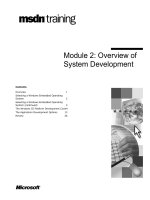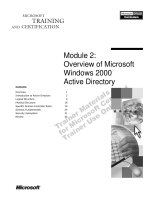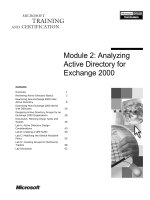Module 2: Overview of System Development
Bạn đang xem bản rút gọn của tài liệu. Xem và tải ngay bản đầy đủ của tài liệu tại đây (1.11 MB, 30 trang )
Contents
Overview 1
Selecting a Windows Embedded Operating
System 2
Selecting a Windows Embedded Operating
System (continued) 3
The Windows CE Platform Development Cycle4
The Application Development Options 13
Review 26
Module 2: Overview of
System Development
Information in this document, including URL and other Internet Web site references, is subject to
change without notice. Unless otherwise noted, the example companies, organizations, products,
domain names, e-mail addresses, logos, people, places, and events depicted herein are fictitious,
and no association with any real company, organization, product, domain name, e-mail address,
logo, person, places or events is intended or should be inferred. Complying with all applicable
copyright laws is the responsibility of the user. Without limiting the rights under copyright, no
part of this document may be reproduced, stored in or introduced into a retrieval system, or
transmitted in any form or by any means (electronic, mechanical, photocopying, recording, or
otherwise), or for any purpose, without the express written permission of Microsoft Corporation.
Microsoft may have patents, patent applications, trademarks, copyrights, or other intellectual
property rights covering subject matter in this document. Except as expressly provided in any
written license agreement from Microsoft, the furnishing of this document does not give you any
license to these patents, trademarks, copyrights, or other intellectual property.
2001 Microsoft Corporation. All rights reserved.
Microsoft, MS-DOS, Windows, Windows NT, Visual Studio are either registered trademarks or
trademarks of Microsoft Corporation in the U.S.A. and/or other countries.
The names of actual companies and products mentioned herein may be the trademarks of their
respective owners.
Module 2: Overview of System Development iii
Instructor Notes
This module provides students with an overview of the system development
process for a Windows CE .NET project. It covers the decision making process
of identifying which operating system suits your requirements, Window CE
.NET or Windows XP Embedded. It also describes the Windows CE platform
development cycle.
After completing this module, students will be able to:
Compare Windows CE .NET and Windows XP Embedded.
Explain the platform development cycle.
Describe the application development options.
Materials and Preparation
This section provides the materials and preparation tasks that you need to teach
this module.
Required Materials
To teach this module, you need the following materials:
Microsoft
®
PowerPoint
®
file 2530A_02.ppt
Preparation Tasks
To prepare for this module:
Read all of the materials for this module.
Module Strategy
Use the following strategy to present this module:
Selecting a Windows Embedded Operating System
Briefly explain the differences between Windows CE .NET and Windows
XP Embedded and discuss the questions that should be asked for arriving at
the decision about which operating system should be used, Windows XP
Embedded.
The Windows CE Platform Development Cycle
Describe the pattern of a typical project and the ways Windows CE .NET is
designed to shorten the cycle by using rapid start and parallel development
features.
The Application Development Options
Explain the Native and Managed development models and discuss the
difference between the two.
Presentation:
60 Minutes
Module 2: Overview of System Development 1
Overview
Selecting a Windows Embedded Operating System
The Windows CE Platform Development Cycle
The Application Development Options
In this module, you will learn how to select between Windows CE .NET and
Windows XP Embedded. You will then learn about the platform development
cycle for Windows CE, including features that allow you to minimize
development time by using parallel development. Finally, you will learn about
the available tools and options for developing Windows CE applications.
After completing this module, you will be able to:
Compare Windows CE .NET and Windows XP Embedded.
Explain the platform development cycle.
Describe the application development options.
Topic Objective
To provide an overview of
the module topics and
objectives.
Lead-in
In this module you will gain
an understanding of the
overall Windows CE
development process, from
choosing the operating
system in the first place to
final testing at the end.
2 Module 2: Overview of System Development
Selecting a Windows Embedded Operating System
Selecting a Windows Embedded Operating System
Battery Powered?
CPU Architecture?
OS RAM Footprint?
Use Existing Applications?
<16~MB
No
Any CE
Supported
Yes
Yes
>~16 MB+
X86 PC
No
The answers to these questions help you in selecting the right operating system:
• Is your device battery powered?
• Which CPU architecture?
• Any RAM footprint limitations?
• Need to use existing Win32 applications and Windows drivers?
Topic Objective
To describe the decision
method for selecting
between the Windows CE
and Windows XP
Embedded operating
system.
Lead-in
Present a decision method
for selecting between the
two operating systems:
Windows CE and Windows
XP Embedded.
The first step in a Windows
Embedded project is to
select the right operating
system according to your
needs…
Delivery Tip
Some people in this course
may be evaluating Windows
CE to decide if it is right for
their project. This topic
helps to clarify them the key
differences between CE and
XP.
You may want to ask if there
is any student in the class
with this requirement, if no
you can abbreviate the
topic.
Module 2: Overview of System Development 3
Selecting a Windows Embedded Operating System
(continued)
5 MB – 35 MB+200KB – 14MB+Image Size
Windows 2000/XP
Target Designer
Windows 2000/XP
Platform Builder
Development
Environment
Same as XPImproved over 3.0Security
Same as XPFine-tuned for sizeDevice Driver
Pentium class x86x86, MIPS, SHx, ARMCPU Support
Complete Win32, same
as XP
Best of Win32 plus
Windows CE-specific
enhancements
API Support
ModularExtremely modularConfigurability
500 k – 16MB5MB - 56MBDisk Space
Windows XPEWindows CEFeature
The Microsoft strategy is to offer a broad range of Windows-based, embedded
operating-system solutions to meet the diverse needs of customers. Ultimately,
the design requirements of your device determine the platform to be used. But
understanding the development focus of each operating system may assist you
in making this decision.
Use Windows CE .NET for solutions requiring real-time, small footprint,
battery power, low unit cost, and support for multiple processor types.
Use Windows XP Embedded for solutions requiring the latest Windows
technologies built on the x86 processor.
Topic Objective
To compare the key
features of the two operating
systems.
Lead-in
Some of the key differences
between CE and XPE are
laid out in the table on the
slide….
4 Module 2: Overview of System Development
The Windows CE Platform Development Cycle
Getting Started Quickly With Platform Builder
Taking Advantage of Parallel Development
Typical Project Timeline
Moving from SDB to Custom Hardware
The Iterative Development Process
This section covers the main stages of a Windows CE platform development
project and highlights the new features of Platform Builder that make projects
faster and more efficient.
Topic Objective
Explain the platform
development cycle.
Lead-in
The main stages of the
development cycle in
Windows CE are…
Module 2: Overview of System Development 5
Getting Started Quickly with Platform Builder
New Platform Wizard:
provides a start
z
Select a base configuration
for your platform
z
Click initial features
z
Click preconfigured BSP
Basic configurations
z
Starting point for the
creation of an operating
system
z
Select from New Platform
Wizard
The first step in platform development cycle is to use Platform Builder to create
a base configuration. You can use the New Platform Wizard in Platform
Builder to quickly and easily configure your platform.
Platform Builder
Microsoft Platform Builder delivers all the tools developers need to build
Windows CE-based embedded systems. The Platform Builder Integrated
Development Environment (IDE) includes wizards and toolbars for creating
platforms and components, compilers, a full set of resource editors, a kernel
debugger, and a tool for exporting a custom software development kit (SDK).
Platform Builder runs on Microsoft® Windows® 2000 Service Pack 2
Workstation or Windows XP RC1 Professional (build 2505 or later).
New Platform Wizard
The New Platform Wizard provides you with a series of interactive dialog
boxes, which allow you to:
Select a base operating system (OS) configuration for your platform.
Choose initial operating system features.
Choose a preconfigured Board Support Packages (BSP).
After you have chosen your initial settings, the New Platform Wizard sets up
the environment with files that support the operating system configuration you
have selected.
The Windows CE features included in your platform depend on the operating
system configuration that you select. You can build a system with a little more
than a kernel, a system with a complex graphical user interface (UI) and
preinstalled applications, or any type of a system in between.
Through a series of interactive dialog boxes, the New Platform Wizard enables
you to select:
Topic Objective
To create a base
configuration using the New
Platform Wizard.
Lead-in
The New Platform Wizard
provides you with an instant
base configuration as a
starting point for your
project. .
Delivery Tip
The term Platform Builder is
commonly used to refer to
the IDE interface alone,
though in fact Platform
Builder includes the larger
set of tools and files that
make it possible to build a
working Windows CE
image.
6 Module 2: Overview of System Development
One of the many base configurations and their variants or any configuration
in the catalog
One of the preconfigured BSPs or one you have created yourself
Additional applications and media you wish to include, such as Internet
Browser, Pocket Word, and Media Player.
Networking and communication options you wish to include, such as
Infrared Data Association (IrDA), Bluetooth, and Point to Point Protocol
(PPP).
Any other features you wish to add using drag and drop.
Basic Configurations
Platform Builder provides basic configurations as starting points for the
creation of an operating system. The configurations are provided to give you a
start with a specific class of device. Configurations, in combination with a BSP,
are intended to reduce bring-up time and time to market. Once a basic
configuration is chosen, you may modify it to suit your specific needs.
Delivery Tip
The basic configurations,
based on real-world device
types, are an important new
feature in Windows CE.
These basic configurations
replace the configurations in
previous versions, such as
Maxall and Minkern.
Module 2: Overview of System Development 7
Getting Started Quickly with Platform Builder (continued)
CEPC Emulator
z
A virtual target hardware platform on the workstation
z
Allows system development to begin without any target
hardware attached, including applications and
debugging
SDBs and BSPs in Platform Builder
z
Choose the board closest to your own architecture
z
Sample board support packages are provided
z
Develop for the board until your hardware is ready
Windows CE .NET supports a wide variety of development platforms, both
emulated and real.
CEPC Emulator
A tool designed to emulate the behavior of hardware, built using Platform
Builder on a standard workstation. The Emulator has been integrated into
Platform Builder so that users can create a virtual hardware reference board
instead of using a CEPC to test their platforms.
SDBs and BSPs in Platform Builder
Out-of-the-box BSP support is provided for nine commercial off-the-shelf
(COTS) hardware reference platforms also known as Standard Development
Boards (SDBs) that cover the full range of supported microprocessors. The
generic CEPC platform is also supported. This out-of-the-box support allows
OEMs to quickly evaluate their operating system features on their reference
hardware and cut down on time to market issues while designing products with
Windows CE.
Topic Objective
To introduce the Emulator
and Standard Development
Boards (SDB) options.
Lead-in
What will you use as a
target device for early
system development? You
have two main options….
Delivery Tip
Point out that the emulator
and the wide range of SDBs
supported by BSPs are new
features of Windows CE
.NET. In previous versions,
only two hardware platforms
were supported out-of -the-
box: CEPC and ODO.
For Your Information
The BSPs and SDBs were
listed in Module 1,
“Overview of Microsoft
Windows CE .NET”, in
Course 2530A, “Introduction
to Windows CE .NET”.
8 Module 2: Overview of System Development
Taking Advantage of Parallel Development
Port H/W Customize OS Develop Apps
Linear Development Model
Parallel Development Model
Port H/W
Customize OS
Develop Apps
Windows CE .NET is designed to reduce or eliminate dependencies in the
development cycle that tend to extend the time frame of a project.
Work on customizing the Windows CE operating system is not dependent on
the development of custom hardware and the bring-up of Windows CE on that
hardware. Operating system customization can begin on Platform Builder
Emulator, then move onto a CEPC or a wide variety of SDBs, and finally onto
custom hardware when it is brought up.
Likewise, application development is not dependent on the completion of
platform development. Native application work can begin in the emulation
environment of eVC, and then can move onto SDBs and custom hardware as
these become available. Likewise managed applications can be developed using
only Visual Studio .NET with Smart Device Extensions, then moved to
hardware when it’s available.
As a result it is possible to have a porting team, a customization team, and an
applications team working in parallel to achieve the shortest overall
development time frame.
Topic Objective
Describe the advantages of
parallel development.
Lead-in
One way to compress the
development schedule is
using parallel
development…
Module 2: Overview of System Development 9
Typical Project Timeline
Boot loader
OAL
Time
Time
Driver A
Driver B
Driver N
App Development on SDB
OS Optimization on H/W
OS Optimization on H/W
Final Validation
Porting Complete
Porting Complete
OS Customization on SDB
OS Customization on SDB
Early Testing
App Dev on H/W
Project Complete
Project Complete
Hardware Stable
Hardware Stable
Porting
OS
OS
Apps
QA
% Complete
% Complete
The illustration in the slide shows how the main platform development tasks fit
into a typical project timeline. In a typical platform development scenario, you
first build a basic operating system image, download it to a hardware
development platform, such as a Standard Development Board (SDB) or the
Emulator, and then refine and debug the platform. After refining and debugging
the platform, you adapt it for your custom target device. If you are not using a
standard BSP, you must create a boot loader and an OEM Adaptation Layer
(OAL) before you can download your operating system image to your target
device. You use a boot loader to download code such as an operating system
image to a target device.
Topic Objective
Explain the typical project
timeline.
Lead-in
Here is a project timeline
that demonstrates parallel
development in practice…
For Your Information
For more information about
porting, see course 2535A,
“Developing a Board
Support Package for
Microsoft Windows CE
.NET” and for more
information about advanced
operating system and
application techniques, see
course 2540A, “Developing
Embedded Solutions Using
Microsoft Windows CE
.NET”.









